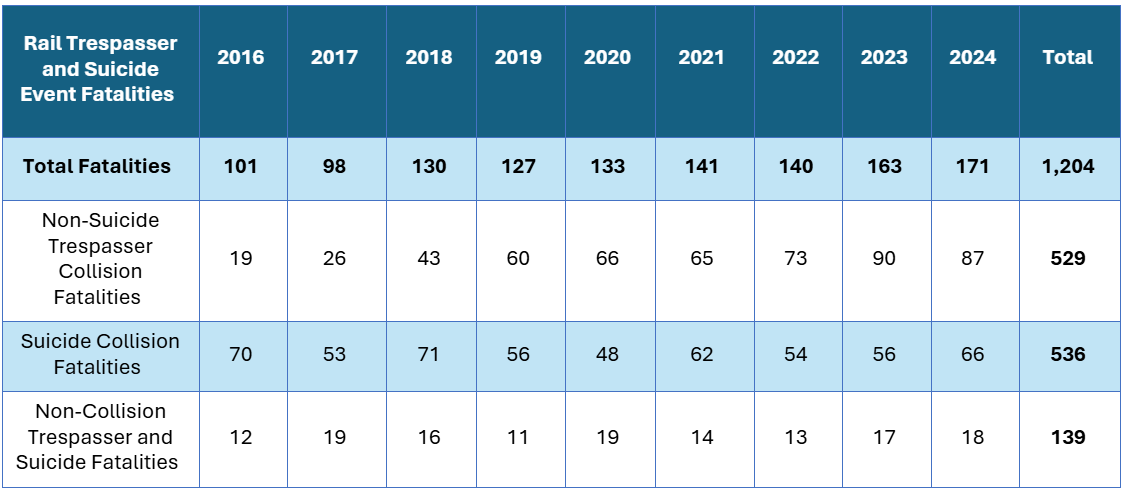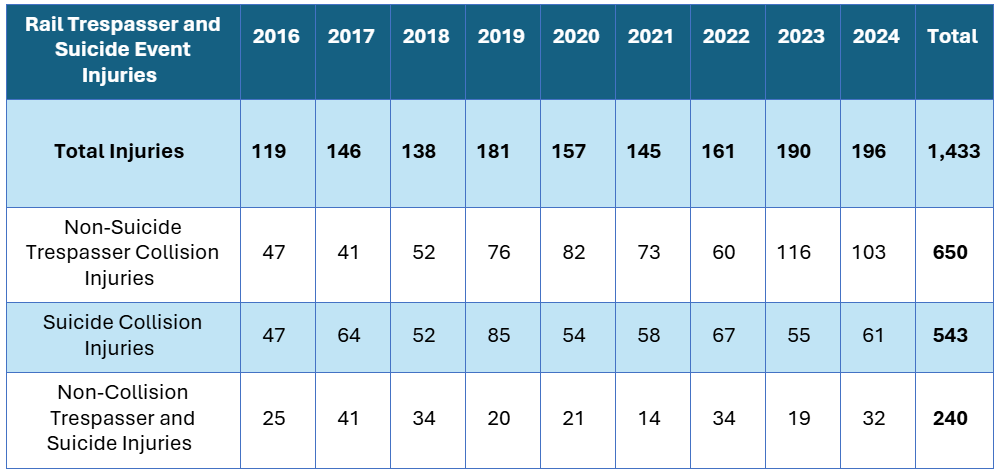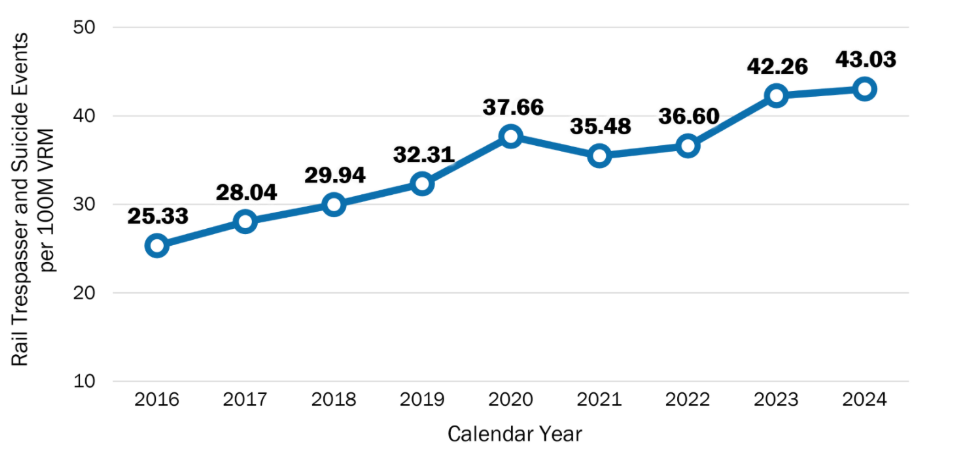Reducing Rail Trespassing and Suicide Events Safety Advisory 25-1
Overview
Trespasser- and suicide-related events have been steadily increasing in the transit industry and are the leading source of transit-related fatalities. In December 2022, FTA addressed this growing concern by publishing SA 22-4: Suicide Prevention Signage on Public Transit to encourage transit agencies to implement, update, or expand suicide prevention signage and messaging campaigns that apply best practices for reducing suicide attempts.
Given the increase in trespasser- and suicide-related events, FTA issued Safety Advisory 25-1: Reducing Rail Trespassing and Suicide Events, which recommends that State Safety Oversight Agencies (SSOAs) direct rail transit agencies (RTAs) in their jurisdiction to use their Safety Management Systems to identify hazards, perform safety risk assessments and identify safety risk mitigations to reduce safety risk associated with trespassing and suicide events.
Background
Trespasser- and suicide-related events account for 50 percent of all fatalities reported to the National Transit Database (NTD) in calendar year 2024. When comparing 2016 to 2024, rail suicide and trespass safety events, fatalities, and injuries steadily increased:
- Rail suicide and trespass events increased 71 percent
- Fatalities increased 70 percent
- Injuries increased 65 percent
FTA analyzes trespasser and suicide-related events together due to the overlap of events that may be considered both trespassing and suicide, and risk mitigations for these events. These events include:
- Customers intentionally jumping, walking or lying in front of trains
- Individuals trespassing on the rail right-of-way from station platforms
- People entering tunnels or track areas to shelter, resulting in collisions or electric shock
Data
Figure 1: Rail Trespasser and Suicide Major Events, Fatalities, and Injuries, Calendar Years (CY) 2016–2024[1]

In this expanded analysis of rail trespassing and suicide major events, FTA has organized safety major event data reported to the NTD into the following categories:
- Suicide Collisions: Collisions involving trains where the person attempting suicide is injured or killed. The individual may or may not have also been trespassing during the event.
- Non-Suicide Trespasser Collisions: Collisions involving trains where a person who was trespassing at the time of the collision was injured or killed as a result of the event, but no person involved attempted or died by suicide.[2]
- Non-Collision Trespasser and Suicide Events: Events that do not involve a collision with a train but where a person is injured or killed as the result of trespassing or a suicide attempt.[3] People injured or killed during these events could potentially be attempting suicide and trespassing at the same time.
From 2016 to 2024,[4] the rail transit industry experienced a significant increase in the rate of trespassing and suicide events. The rates presented below reflect major safety event reports to the NTD as of April 30, 2025, from rail modes under FTA safety jurisdiction.[5] Data is presented per 100 million vehicle revenue miles (VRM).
Figure 2: Rail Trespasser and Suicide Major Event Rate, Calendar Years (CY) 2016–2024
Figure 3: Rail Trespasser and Suicide Major Events by Category, CY 2016 to 2024

-
Non-Suicide Trespasser Collisions have increased from 2016 to 2024 (these include collisions with rail vehicles that have not been confirmed as an attempted suicide and involve trespassers who have entered the rail right-of-way (ROW)). Further analysis demonstrates:
-
The annual number of Non-Suicide Trespasser Collisions that occur within station limits increased from 20 to 100 from 2016 to 2024.
-
The annual number of Non-Suicide Trespasser Collisions occurring at surface-level grade crossings and intersections increased from 5 to 20 over the same period.
-
-
Suicide Collisions and Non-Collision Trespasser and Suicide Events have fluctuated since 2016, with no notable downward trend in events.
Figure 4: Rail Trespasser and Suicide Fatalities by Category, CY 2016 to 2024

Figure 5: Rail Trespasser and Suicide Injuries by Category, CY 2016 to 2024

[1] More information on the major event, fatality, and injury thresholds and definitions used in NTD reporting is available in the NTD Safety and Security Report Policy Manual.
[2] This category also includes collisions where the NTD event report did not include any trespasser fatalities or injuries but did contain categorical data indicating that the transit vehicle collided with a person outside a motor vehicle who was not a transit worker, and that the collision occurred on exclusive rail right-of-way away from intersections, grade crossings, or any transit agency facility, including but not limited to transit stations and stops.
[3] This category excludes categorized security events, including but not limited to assaults, hijackings, and homicides, where a person injured or killed was attempting suicide, died by suicide, and/or was trespassing at the time of the event.
[4] Calendar Year 2024 data are preliminary and subject to NTD reporter revision.
[5] Rail modes include cable car, heavy rail, hybrid rail, inclined plane, light rail, monorail / automated guideway, and streetcar modes.
Best Practices and Resources
The Federal Transit Administration (FTA) has gathered rail trespassing and suicide event resources to support the transit industry in the prevention of rail trespassing and suicide events.
These resources include reports, webinars, videos, web pages, and other tools offered by FTA, Federal Railroad Administration (FRA), the Transportation Research Board, VOLPE, transit agencies, and other organizations. Agencies may consider using these resources to assist in maximizing safety performance and mitigating risks, as appropriate.
Transit agencies may choose to develop their safety risk mitigations across the foundational “3 Es” safety framework: engineering solutions to prevent access and mitigate risk, education to intervene early, and enforcement and partnerships for coordinated response. Additional information about the “3 Es” safety framework can be found in FTA Report No. 0227: Mitigations for Trespasser and Suicide Fatalities and Injuries.
Transit agencies may also refer to the Transit Advisory Committee for Safety (TRACS) Trespass and Suicide Prevention Final Report for relevant information. Transit agencies may also reference FTA Safety Advisory 22-4 for information concerning suicide prevention signage on public transit.
DISCLAIMER: The following list is provided for illustration purposes only. The U.S. government, including FTA, neither endorses nor guarantees in any way the external organizations, services, advice, or products included in these website links. Furthermore, the U.S. government neither controls nor guarantees the accuracy, relevance, timeliness, or completeness of the information contained in non-government website links. If you select a link to an outside website, you are leaving the DOT.gov website and are subject to the privacy and security policies of the external website.
|
Engineering Solutions to Prevent Access and Mitigate Risk |
Site-Specific Projects
Detection Technologies
Other
|
|
Education and Engagement to Intervene Early |
Public Awareness Campaigns
Frontline Staff Training
Mental Health First Aid and De-Escalation Strategies
Other
|
|
Enforcement and Partnerships for Coordinated Response |
Public Campaigns and Reporting Tools
|

